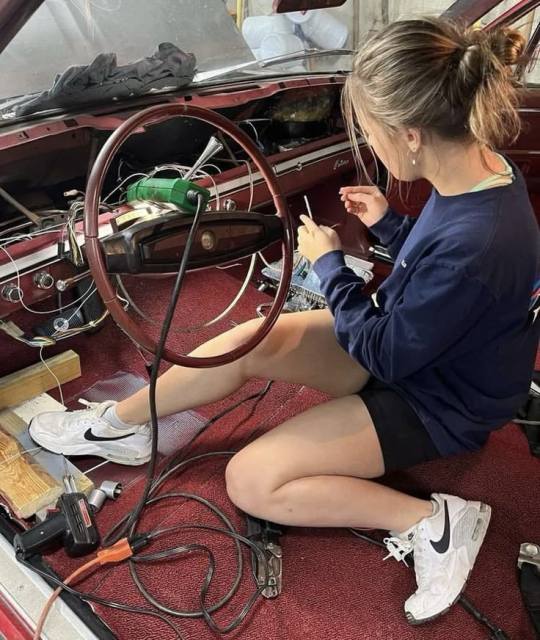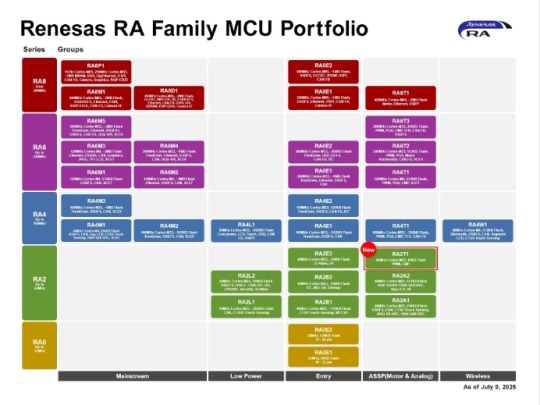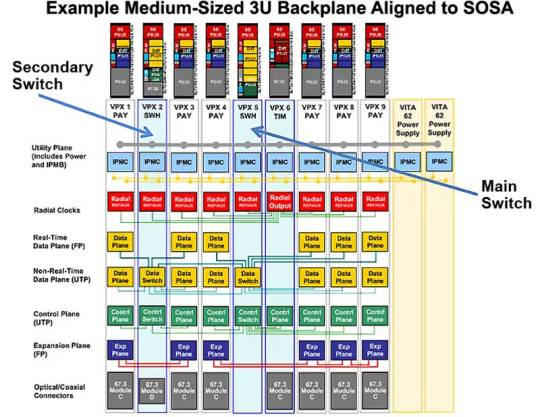#12. High-Speed Data Transfer
Explore tagged Tumblr posts
Text
"Bluetooth: Conectando Dispositivos y Culturas a Través de la Innovación Inalámbrica"

View On WordPress
#1. Bluetooth Technology#10. Bluetooth Versions#11. Device Interoperability#12. High-Speed Data Transfer#13. Bluetooth Low Energy (BLE)#14. Internet of Things (IoT)#15. Historical Influence in Technology.#2. Wireless Communication#3. Harald Blåtand#4. Ericsson Innovation#5. Short-range Connectivity#6. SIG: Bluetooth Special Interest Group#7. Bluetooth Evolution#8. WPAN and Piconet#9. Frequency Hopping
0 notes
Text
High Torque — Lando Norris x Engineer!Reader — part one
Lando Norris doesn't want to admit it, but he may have developed a crush on McLaren's new engineer.



When Y/N L/N walked through the paddock entrance, the McLaren lanyard swinging around her neck, Lando Norris didn’t notice the high-resolution tablet in her hands or the badge listing an absurd string of academic credentials. All he saw were the long legs, the mirrored sunglasses, and the purposeful stride of someone who seemed far more interested in ignoring the world than being part of it.
“Who’s that?” Lando asked, leaning against the team hospitality wall, sipping on a half-warm Red Bull.
Beside him, Oscar Piastri shrugged.
“New engineer. Just transferred from the States. MIT. PhD from Caltech.”
Lando raised an eyebrow, skeptical.
“Seriously? She looks more like a Victoria’s Secret model than an engineer.”
Oscar let out a quiet chuckle.
“Careful. That kind of thinking gets you sued.”
“I’m just saying what everyone’s thinking. It’s like… I don’t know, she can’t be both. Either she’s a genius or she belongs on a magazine cover.”
At that moment, Y/N walked past them as if they were part of the scenery. Eyes fixed on her tablet, not even acknowledging that two drivers stood mere steps away. Lando tilted his head, watching her.
“And she walks like she was born in a private helicopter. Nose so high up she’s probably got a crick in her neck.”
Oscar laughed.
“Maybe you’re the one with the ego problem.”
“Me? I just like knowing who I’m dealing with. And so far, all I see is an attitude.”
***
But it didn’t take long for Y/N to prove she was far more than just an attitude.
At the Hungarian Grand Prix, with erratic rain forecasts and fluctuating temperatures, the team was still debating between three strategies when Skylar stepped into the briefing room and cut through the noise with a firm voice:
“If you don’t switch to intermediates right after Turn 4 on Lap 36, we’ll miss the ideal window. I’ve already modeled it based on cross-referenced radar simulations and traction loss in Sectors 2 and 3. Telemetry shows a 14% drop in grip, and Lando will start losing the rear on corner exits.”
The chief engineer frowned. But Zak Brown, who was starting to realize this girl knew her stuff, gave the green light. The pit stop happened exactly as she said.
And Lando won.
His first victory of the season.
Amid the celebrations, as the entire team congratulated him, only one person occupied his thoughts—the girl who had predicted the perfect timing with surgical precision. He found her in the back of the garage, adjusting data on one of the monitors.
“Hey,” he said, breathless, helmet still in hand, grinning wider than the track itself. “You… that was incredible. You won me that race.”
She didn’t even look up. Just murmured, flatly:
“It’s my job.”
He stood there for a moment, waiting for something more. A smile. A “congrats to you too.” Nothing. Y/N was already typing something else.
On his way back to the motorhome, Lando huffed, laughing to himself, and said to Oscar:
“She’s like a colder, genius, more stuck-up version of Tony Stark. Just without the fun part.”
Oscar raised an eyebrow.
“So what you’re really saying is you have a crush on her.”*
“What? No! I just think… she’s interesting.”
“Uh-huh. Interesting. Like the aerodynamics of a Red Bull.”
***
But the next race didn’t end as happily.
It was Spa. Wet practice. High-speed corners, brutal braking zones. Since Friday, Y/N had been reporting a lag in the electronic differential response, especially at the exit of Turn 12—a critical high-load section where torque needed to redistribute instantly.
She had sent reports, graphs, MATLAB simulations. No concrete response. No adjustments were made. So she gave up, sat in a corner and waited for the disaster she knew was going to happen.
In the race, Lando lost the rear exactly where she predicted. The car spun, nearly crashed. He managed to keep going but finished tenth.
In the post-race debrief, no one mentioned the technical failure. But when the team’s eyes turned to Y/N, she understood the message.
Once again, it was her fault. It wasn't their fault for ignoring her so much that she gave up on delivering the message. Because warning them in advance was never enough. Because being a woman here meant being guilty by default.
"If you were so good in the beginning, how did you not see this coming, girl prodigy?" An intern said with a laugh, and others laughed sarcastically.
That was enough for her.
She locked herself in the engineering motorhome and finally let her face fall into her hands.
That’s where Lando found her.
“Y/N?”
She didn’t turn around.
“Here to tell me I ruined your race?” Her voice was muffled.
“I came to see if you were okay.”
She laughed, bitter.
“This isn’t about being okay, Lando. I don’t have that luxury. Everyone here gets to make mistakes. You. Oscar. The chief engineer. Me? I have to be right before the mistake happens. I have to shout louder. Walk straighter. Back everything up with twice the data. Be a machine. And even then, no one listens until the car spins.”
He sat on the couch across from her, awkwardly, arms resting on his knees.
“You’re not a machine.”
“Sometimes it feels like the only way to survive.”
She finally looked at him. Red-rimmed eyes, but not fragile. Furious. Human.
“I warned them about the differential. There was a 0.3-second delay in torque redistribution between the axles. That’s an eternity in Formula 1. But because I’m just ‘the pretty girl who talks smart,’ they let it slide.”
Lando took a deep breath, then moved closer and—in a rare gesture for someone who usually deflected everything with a joke—pulled her into a hug.
“You’re the smartest person on this team. Your strategies are the boldest, sharpest I’ve ever seen. And even if no one else says it, I know I won that race because of you. And I lost this one because no one listened.”
She didn’t say anything, but she didn’t pull away. For a few seconds, the hum of the servers in the background was the only sound between them.
And maybe, for the first time since she’d entered Formula 1, Y/N allowed herself to stop fighting.
Just for a moment.
***
The tension in the pre-race briefing was as thick as wind tunnel air. They were at Suzuka, and the forecast of strong crosswinds through Turns 8 and 9 changed everything. The rear wing setup was the center of debate, with two engineers arguing for the standard configuration.
Then Y/N looked up from her tablet.
"If we reduce the wing angle by 3.5 degrees and compensate with diffuser adjustments, the car will have better lateral stability without sacrificing too much drag. The wind is cutting diagonally from the west sector, and sensors show micro-oscillations on the Y-axis. The chance of oversteer increases by 12% if we keep the default setup."
Silence.
The chief engineer sighed.
"L/N, with all due respect, we’re not changing what’s already working."
Y/N snapped her tablet shut harder than necessary.
But before she could retort, Lando stood up.
"Why aren’t you listening to her? She was the only one who got Budapest right, and no one believed her at Spa—look how that turned out."
"Lando—"
"No, seriously. I’m the one strapping into that cockpit at 300 clicks an hour, so I damn well get a say. Do the adjustment like she said."
The engineer crossed his arms.
"This isn’t personal. It’s about risk."
"The biggest risk is ignoring the most accurate analysis in this room. I trust her. Make the change."
All eyes turned to Y/N. For the first time, someone—the driver, the face of the team—was demanding they trust her.
***
The car performed exactly as she predicted.
Lando flew across the track, keeping control even through the most critical corners, where the wind tried to swat the car aside like it was made of paper. He won. By a landslide.
Post-race, the chief engineer pulled her aside in a quiet corner of the garage, away from cameras.
"L/N..." He scratched the back of his neck, swallowing pride. "Outstanding work. Your read was spot-on. We nailed it because of you."
She blinked, as if she hadn’t expected to hear that.
"Thank you, sir," she replied, biting back a smile.
He turned to leave. And that’s when Lando, across the garage, saw it.
Y/N took a step back, glanced discreetly to the side, thinking no one was watching. And then—she smiled. A wide, genuine, almost childlike grin. She closed her eyes for a second, bit her lip, and raised both fists in a quiet, contained celebration. Like she’d just scored a goal against the world.
Lando couldn’t stop the stupid grin spreading across his face. That was the first time he’d ever seen Y/N L/N truly smile.
And right then, he knew for sure:
He had a massive, hopeless crush on the most brilliant and impossible engineer in Formula 1.
***
The paddock was nearly empty, lights dimmed and equipment crates stacked, when Lando spotted Y/N sitting alone in a corner of the garage. Her race suit was unzipped to her waist, the tight black tank beneath clinging to her skin from the day’s heat. Loose strands of hair stuck to her neck, and she absentmindedly chewed on the cap of her water bottle, eyes locked on the tablet beside her.
Lando almost turned around. Almost.
But he took a deep breath, grabbed two lukewarm beers and a questionable snack pack from his bag, and walked over.
"Hey, Dr. Stark. Victory secured, ego fed... and I brought the traditional British celebration combo."
She raised an eyebrow.
"Beer and...?"
"Pork scratchings," he said, shaking the little bag. "Fried pig skin. A delicacy."
"Is that even real food?"
"It’s British, which automatically makes it traditional, questionable, and highly likely to be indigestible. Want some?"
She took the beer and eyed the snack like it was a suspicious lab specimen.
"This looks like something I’d find on the floor of a test car."
"That’s the texture, yeah. Also the flavor."
She laughed and cracked open the can. Took a sip and immediately grimaced.
"Wow. This tastes like a rusty bolt dipped in petrol. British cuisine really is a joke."
"GORDON RAMSAY IS BRITISH!"
She burst out laughing, nearly choking.
"That’s your argument?"
"Absolutely. We’ve been producing grumpy geniuses and weird snacks since the Industrial Revolution."
She raised her beer in a toast.
"To the Revolution."
"And to stuck-up engineers finally admitting you’re a genius."
The cans clinked with a hollow, metallic sound. Y/N took another sip and smirked.
"Did you see his face? I swear, I thought he’d rather swallow a wrench than admit I was right."
"Historic," Lando said, sitting beside her, elbows on his knees. "You looked like a movie hacker. Whole room frozen, and you just drop a simulation that blew up everyone’s assumptions."
She shrugged, but the smile still played on her lips.
"It’s not that big a deal."
"MIT and Caltech?" He turned to look at her with a half-smirk. "Y/N, that’s Hollywood stuff. So you’re, like, an actual genius?"
She huffed a laugh, shaking her head.
"Hardly. I was just good at math. But being a woman in this world? Being good turns into suspicion. You have to do three times the work with half the credibility. My family didn’t have money. I spent my teens juggling scholarships, internships, and all-nighters."
He listened quietly, watching her with more focus than usual.
"Got into MIT at sixteen," she added, like it was nothing.
Lando’s eyes widened. "You’re trying to convince me you’re not a genius... SIXTEEN AT MIT?!"
She laughed, and when he made an exaggerated scandalized face, she shoved his shoulder lightly.
"If you saw the grind... there was nothing magical about it. Just discipline, pressure, and way too much Red Bull."
"That makes it even cooler," he said, softer now.
She looked at him, surprised by the tone. He took a sip of beer, glancing away like he didn’t want to seem too impressed.
"Like... you didn’t just fall into this, you know? You built your own damn rocket."
Y/N was quiet for a moment. Then she smiled—not the usual sarcastic smirk, but a real, almost shy one.
"Thanks."
"S’nothing. Just trying to keep up with the prodigy engineer who tweaks my car’s aerodynamics and still roasts my snacks."
"And your beer. Let’s not forget."
"Okay, that was a direct attack on British culture, but I’ll let it slide."
She took another sip and leaned back against the crate.
"You know... you’re not as much of a prick as I thought."
"Is that a compliment?"
"No"
#fanfiction#lando norris#lando x reader#lando norris x reader#f1 x reader#f1 imagine#f1 fanfic#lando norris imagine
270 notes
·
View notes
Text
PARAMEDIC!SUGURU



CONTENT WARNINGS: fluff, smut, strangers to lovers trope, reader passes out, ambulances, sutures, blood, soft!suguru
sena’s note: i’m so down bad for jjk men i don’t have any words… i’m tweaking rn just thinking about suguru in paramedic gear—
MINI-SERIES MASTERLIST

➩ PARAMEDIC!SUGURU who was just about to call it a night with his coworker and drive back to the fire station to be relieved by the night shift, but held back a groan when a call came in
➩ PARAMEDIC!SUGURU who was told that a lady in her twenties had passed out and hit her head while at work, and who forgot all about after hours as his colleague drove towards the workplace at full speed with blasting sirens
➩ PARAMEDIC!SUGURU who rushed inside the building of the given address — a restaurant — with his colleague, paramedic backpack draped over his shoulder to be fetched by the shift supervisor who had made the call
“i don’t know how it happened... she was prepping in the back along with another worker and i suddenly heard clattering. when i checked, she was passed out and bleeding all over the floor.”
suguru’s amber eyes narrowed at the way the man explained the situation, and he left it to his colleague to register the workplace’s and your data while he entered the back to see you seated on a chair, weakly holding a cloth against your profusely bleeding forehead.
“ma’am, i’m here to help. may i check?” his voice was mellow and smooth, and you lowered your shaking arm to let his gloved hand check beneath the cloth. you were barely able to sit, yet, you looked at your coworker with exhausted eyes. “i’m okay... why did you call the ambulance…? he’s probably mad now.”
“you’ll need stitches for that wound,” he informed you, which made you sigh shakily as you gazed up at the tall man. all you saw was a blurred, tall silhouette wearing a vibrant, red uniform that stung your eyes, and a bun of dark, long hair. “my colleague will be here with a stretcher. could you look at me for a quick second?”
long, gloved fingers gently lifted your chin to check your pupillary response with an ophthalmoscope, discovering that your pupils were unusually dilated. high chance of a concussion. when you heard a stretcher rolling inside the room, you let out a confused hum.
“i—i can walk,” you slurred, accompanied by the supervisor also annoyingly confirming that there was no need for the stretcher. suguru quirked a brow at your supervisor, beckoning his colleague closer with the stretcher.
“there absolutely is a need for that,” he countered, “now kindly back away, sir.” his tone was warning, and the older man hesitantly stepped away while the two paramedics lifted you off the chair carefully to lay you down on the stretcher, securing you as you gazed up with blank, confused eyes.
geto stayed in the back with you during the drive to the hospital, and he made sure to check your vitals and ask you questions to make out the severity of your concussion and to see how well you responded.
➩ PARAMEDIC!SUGURU who found it endearing that you insisted for him to hold your hand throughout the ride because you had never been in an ambulance and it was scary and cold
➩ PARAMEDIC!SUGURU whose eyes didn’t leave your form until you were brought into a treatment room, barely able to let go of your hand
➩ PARAMEDIC!SUGURU who only noticed at the fire station after clearing out the ambulance that there was a silver necklace with your initial in a corner, a necklace he was sure he had seen on you before you were transferred into the ambulance
➩ PARAMEDIC!SUGURU who despite having just gotten off an excruciating 12-hour shift and wanting to have nothing more to do with hospitals for the day, found himself heading back towards the hospital you’d been delivered to
➩ PARAMEDIC!SUGURU who saw you sitting in the hallway, waiting for your CT scans with a bandage around your treated head, and who approached you in civilian attire
➩ PARAMEDIC!SUGURU who returned the necklace to you and helped you put it on, waiting for your results with you while you were still quizzed as to why he was with you, still clearly confused
➩ PARAMEDIC!SUGURU who drove you home because you had no one to pick you up, and who accompanied you all the way to your door; who didn’t leave without taking your number to check on you
➩ PARAMEDIC!SUGURU who really did check in with you very frequently until you were feeling better again, and who was positively surprised to see you at the same hospital again a week later to get your stitches removed
“does this scar make me look goofy? be honest.”
suguru took your hand to stop you from touching the scarred and still sensitive tissue, giving you a soft smile. “no, it just puts a little badass in your adorable self,” he chuckled. your eyes went wide as you looked away bashfully.
“are you off work now?” suguru tilted his head down to look at you, you wouldn’t meet his eyes. cute. “i am. just need to head back to the station and get changed. why?”
“i’m really hungry. you wanna grab food?”
➩ PARAMEDIC!SUGURU who never failed to kiss the scar on your forehead, grazing his fingertips against the imperfectly perfect feature on your face, and who got heart eyes whenever you shyly showed him how much you love him
➩ PARAMEDIC!SUGURU who always subconsciously shielded your head from possible danger; who covered your head with his hand while opening cupboards close to you, or who always covered the edge of a table with his palm when you bent over to pick something up; and who despite being so caring, couldn’t help but poke a little fun at you
“you okay like this, angel?” a shuddered whimper left your lips as you got settled on top of your tall, handsome boyfriend who was laid on his back. plush thighs straddling his sides, you relished in the feeling of him inside of you.
he didn’t move an inch. all he did was stare into your eyes and cradle your face in his warm hands. all you wanted was to show suguru that you were a big girl, that you could take it, that you were—
“i—it’s—,” you moaned into his hand, your own clammy palms shooting forward to clutch at his toned stomach, “y—you’re so mean, sugu! you promised not to move!” his long strands of jet black hair bounced when he chuckled heartily. he couldn’t help it.
“i can’t help it when i’m inside the prettiest girl in the world,” he mumbled against your lips, capturing your lips in a greedy kiss that swallowed your moans. “want me to take over? all you have to do is ask.”
your begging eyes were enough for him to flip you over.

tagged: @melancholia-k @tansyfleurwhisper
#jujutsu kaisen#geto suguru smut#geto x reader#jjk smut#jjk x reader#jjk x y/n#geto smut#jjk x you#jujutsu kaisen x reader#jjk fluff#jujutsu kaisen smut#jujutsu kaisen x reader smut#jjk x reader smut#geto suguru x reader#geto suguru#geto suguru x you#geto suguru x y/n#suguru geto x reader#suguru geto x you#suguru geto x y/n#jjk x fem!reader#jjk x reader fluff#jjk geto#jjk geto x reader#jjk suguru#jujutsu kaisen x you#jujutsu kaisen fluff#jjk
1K notes
·
View notes
Text

In 1970s NASA was not allowed to have any SR-71s, yet they received one and they passed it off as YF-12C (with a bogus A-12 tail number)
NASA YF-12C
Taken in 1975, the interesting photos in this post show NASA Blackbirds carrying the so called “coldwall” heat transfer pod on a pylon beneath the forward fuselage.
The Blackbirds portrayed in these photos are usually referred to as YF-12s, but actually one of them was an SR-71: the one on the top is a YF-12 but the one on the bottom is an SR-71.

CLICK HERE to see The Aviation Geek Club contributor Linda Sheffield’s T-shirt designs! Linda has a personal relationship with the SR-71 because her father Butch Sheffield flew the Blackbird from test flight in 1965 until 1973. Butch’s Granddaughter’s Lisa Burroughs and Susan Miller are graphic designers. They designed most of the merchandise that is for sale on Threadless. A percentage of the profits go to Flight Test Museum at Edwards Air Force Base. This nonprofit charity is personal to the Sheffield family because they are raising money to house SR-71, #955. This was the first Blackbird that Butch Sheffield flew on Oct. 4, 1965.
Another interesting thing about those pictures is that NASA was not allowed to have an SR-71 but they did and they passed it off as a YF-12!
In fact, the “YF-12C” was a then-secret SR-71A (serial no. 64-17951, the second production SR-71A) given the NASA tail no. 60-6937. The reason for this bit of subterfuge lay in the fact that NASA, while flying the YF-12A interceptor version of the aircraft, was not allowed to possess the strategic reconnaissance version for some time.
In 1970s NASA was not allowed to have any SR-71s, yet they received one and they passed it off as YF-12C (with a bogus A-12 tail number)

Two NASA Blackbirds: the one on the top is a YF-12, the one on the bottom is the YF-12C/SR-71.
The coldwall project
The bogus tail number actually belonged to a Lockheed A-12 (serial no. 60-6937), but the existence of the A-12 remained classified until 1982. The tail number 06937 was selected because it followed in the sequence of tail numbers assigned to the three existing YF-12A aircraft: 06934, 06935, and 06936. Isn’t that amazing?
The coldwall project, supported by Langley Research Center, consisted of a stainless steel tube equipped with thermocouples and pressure-sensors. A special insulating coating covered the tube, which was chilled with liquid nitrogen. At Mach 3, the insulation could be pyrotechnically blown away from the tube, instantly exposing it to the thermal environment. The experiment caused many inflight difficulties, such as engine unstarts, but eventually researchers got a successful flight.
Noteworthy the Flight Research Center’s involvement with the YF-12A, an interceptor version of the Lockheed A-12, began in 1967. Ames Research Center was interested in using wind tunnel data that had been generated at Ames under extreme secrecy. Also, the Office of Advanced Research and Technology (OART) saw the YF-12A as a means to advance high-speed technology, which would help in designing the Supersonic Transport (SST).
Given that the US Air Force (USAF) needed technical assistance to get the latest reconnaissance version of the A-12 family, the SR-71A, fully operational, the service offered NASA the use of two YF-12A aircraft, 60-6935 and 60-6936.
Eventually, with 146 flights between Dec. 11 1969 and Nov. 7 1979, 935 became the workhorse of the program while the second YF-12A, 936, made 62 flights. Given that this aircraft was lost in a non-fatal crash on Jun. 24 1971, it was replaced by the so-called YF-12C SR-71A 61-7951, modified with YF-12A inlets and engines and a bogus tail number 06937.
The YF-12A
Cool Video Explains how SR-71 Blackbird’s J58 Turbo-Ramjet Engine Works

This print is available in multiple sizes from AircraftProfilePrints.com – CLICK HERE TO GET YOURS. SR-71A Blackbird 61-7972 “Skunkworks”
The SR-71 differed from the YF-12A in that the YF-12A had a round nose while the SR-71 had its chine carried forward to the nose of the airplane. There were other differences in internal and external configuration, but the two aircraft shared common inlet designs, structural concepts, and subsystems.
The YF-12 was developed in the 1960s as a high-altitude, Mach 3 interceptor to defend against supersonic bombers. Based on the A-12 reconnaissance aircraft, the YF-12A became the forerunner of the highly-sophisticated SR-71 strategic reconnaissance aircraft.
The first of three YF-12s flew in August 1963. In May 1965, the first and third YF-12s set several records, including a speed record of 2,070.101 mph and an altitude record of 80,257.65 feet. For their speed record flight, Col. Robert L. “Fox” Stephens (pilot) and Lt. Col. Daniel Andre (fire control officer) received the 1965 Thompson Trophy.
Though the aircraft performed well, the F-12 interceptor program ended in early 1968. High costs, the ongoing war in Southeast Asia, and a lower priority on air defense of the US all contributed to the cancellation.
@Habubrats71 via X
24 notes
·
View notes
Photo

MSI H610M-E PRO Intel LGA1700 M-ATX Motherboard MSI PRO series motherboards help users work smarter by delivering an efficient and productive experience. Featuring stable functionality and high-quality assembly, PRO series motherboards provide not only optimized professional workflows but also less troubleshooting and longevity. MSI motherboards feature tons of convenient and smart designs for DIY users, and countless system tuning and troubleshooting tools are at your disposal to push your system to new heights and satisfy even the most demanding tweaker. This makes it so easy to install your own motherboard without any issues. MSI motherboards let you manage speeds and temperatures for all your system and CPU fans. Total Fan Control allows you to check your primary system characteristics in a simplified graphical interface. You can also set up to 4 temperature targets for CPU and motherboard, which will adjust the fan speeds automatically. Detecting CPU & GPU temperatures and automatically adjusting fan duty of system fans to a proper value by adopting MSI AI ENGINE. The most important thing about DIY is expandability. MSI PRO series motherboards feature plenty of possibilities for prosumers’ needs. Stable LAN, faster storage and USB transfer speeds and other expandable connectors are ready to enlarge your flexibility. Stay connected with Intel® LAN, optimized for stable internet throughput and ideal for championship-level online playing. MSI PRO series motherboards are designed to satisfy any professional workflow. Elevate your listening pleasure and enjoy the extreme sound quality. Moreover, with years of experience in creating performance-enhancing tools that are easy to use, only the highest quality applications are at your disposal. The extensive features let you fine-tune your system to deliver reliable maximum performance. MSI lightning Gen 4 PCI-E is the latest and the fastest PCI-E data transfer solution with 64GB/s of transfer bandwidth that has doubled compared to its previous generation. PCIe 4.0 maintains both backward and forward compatibility with older and newer specifications. Optimized by steel armor design, your motherboards can support the weight of heavy graphics cards. MSI conducts thorough memory testing with the most popular memory brands under extreme conditions to ensure your system runs stable no matter what. Our memory partners include brands like Corsair, Crucial, Kingston, G.Skill and many more to optimize memory modules and configurations. Core Boost technology combines MSI’s premium layout and optimized power design which allows for faster and undistorted current delivery to the CPU at pin-point precision. Not only supporting multi-core CPU, also creating the perfect conditions for your CPU overclocking. FEATURES: Supports 12th Gen Intel® Core™, Pentium® Gold and Celeron® processors for LGA 1700 socket Supports DDR4 Memory, up to 3200(MAX) MHz Core Boost : With premium layout and digital power design to support more cores and provide better performance Memory Boost: Advanced technology to deliver pure data signals for the best performance, stability and compatibility Lightning Fast Experience: PCIe 4.0 Audio Boost: Reward your ears with studio grade sound quality Steel Armor: Protecting VGA cards against bending and EMI for better performance, stability and strength. SPECIFICATIONS: Socket: 1700 CPU Support: Supports 12th Gen Intel® Core™ Processors, Pentium® Gold and Celeron® Processors up to i9 Chipset: Intel® H610 Chipset DDR4 Memory: 3200(MAX) / 3000 / 2933 / 2800 / 2666 / 2400 / 2133 MHz Memory Channel: Dual Channel DIMM Slots: 2 Max Memory (GB): 64 PCI-E x16: 1 PCI-E x1: 1 SATAIII: 4 M.2 Slot: 1 TPM (Header): 1 LAN: 1x Realtek® RTL8111H Gigabit LAN controller USB 3.2 ports (Front): 2(Gen 1, Type A) USB 3.2 ports (Rear): 2(Gen 1, Type A) USB 2.0 ports (Front): 4 USB 2.0 ports (Rear): 4 Audio ports (Rear): Realtek® ALC897 Codec VGA: 1 HDMI: 1 DirectX: 12 Form Factor: mATX Operating System: Support for Windows® 11 64-bit and Windows® 10 64-bit WHAT’S IN THE BOX: MSI PRO H610M-E DDR4 Intel 1700 mATX Motherboard – Black x1 SATA Cables x2 EZ M.2 Clip x1 I/O Shield x1 Quick Install Guide x1
2 notes
·
View notes
Text
Advantages of a 12-core fiber optic cable

A 12 Fiber Cable is a type of optical cable that has 12 separate strands or cores of optical fibers enclosed in a protective jacket. Each core may carry a distinct communication signal, allowing numerous data streams to be delivered concurrently.
Fiber optic cables are composed of tiny strands of glass or plastic fibers that transport data via light pulses. These cables provide various advantages over regular copper cables, such as increased bandwidth, quicker data transmission rates, and greater transmission distances.
The 12-core design is a common choice for fiber optic cables because it strikes an appropriate balance between capacity and cost.
It supports the transmission of numerous signals, making it ideal for applications requiring large data capacity, such as telecommunications networks, data centers, and internet service providers.
In recent years, there has been an increase in demand for larger-capacity fiber optic connections to meet contemporary technology's expanding data requirements. As a result, manufacturers have created cables with even greater core counts, such as 24, 48, or 96 cores. These higher-core-count cables are commonly employed in large-scale data centers and high-capacity backbone networks.
Furthermore, advances in fiber optic technology have resulted in the development of cables with superior performance characteristics, such as faster data transfer speeds and lower signal loss. These advances have expanded the potential of 12 Fiber Pigtail, making them a dependable and effective alternative for a variety of applications.
Advantages of a 12-core fiber optic cable
Increased capacity: This cable has 12 separate fibers, which gives more data transmission capacity than cables with fewer cores. It enables the simultaneous transmission of several signals, resulting in better network flexibility and scalability.
Fiber optic lines provide greater data transfer speeds than standard copper wires. The 12-core architecture adds to this advantage, allowing for high-speed data transmission across great distances.
Improved Reliability: Fiber optic connections are less susceptible to electromagnetic interference and signal loss, resulting in more stable data transfer. The 12-core architecture provides redundancy, guaranteeing that if one or more fibers fail, the network may still function with the remaining fibers.
Future-proofing: The 12 Fiber Cable allows for future extension and technical developments. It enables future updates and the incorporation of new services without requiring significant infrastructure expenditures.

Next: What Is Passive Optical Networking (PON) and How Does It Revolutionize Broadband Connectivity?
2 notes
·
View notes
Text
Price: [price_with_discount] (as of [price_update_date] - Details) [ad_1] Enhance your iPhone or iPad’s functionality with the Yesido GS32 Lightning to USB 3.0 OTG Adapter — a powerful, plug-and-play solution that connects your Apple device to a world of USB peripherals. Whether you need to access files from a USB flash drive, transfer media, connect a keyboard for work, or use a card reader or gaming controller, the GS32 makes it seamless and effortless. Built with USB 3.0 technology, it ensures ultra-fast data transfer speeds up to 5Gbps, letting you move large files in seconds. Crafted from premium-grade aluminum alloy, this adapter is as durable as it is stylish. The robust build resists heat, corrosion, and daily wear — perfect for long-term use at home, work, or on the go. The compact design, combined with a built-in keyring slot, makes it easy to carry wherever you are. Designed specifically for iPhones and iPads with Lightning ports, the GS32 is compatible with iOS 13 and above, supporting FAT32 and exFAT file systems for external storage. It requires no apps, no configuration, and no extra software — just plug and play. This is not just a tool — it’s a productivity booster. Whether you’re a student, business user, content creator, or tech enthusiast, the GS32 allows you to work smarter, faster, and more freely. ✅ CE Certified for safety and quality ✅ Smart chipset for stable data flow ✅ Backed by a full 1-Year Seller Warranty by Empire Birds Enterprises 🔧 Use It To: Read & transfer documents, music, and videos from USB drives Connect a physical keyboard for faster typing Access camera content via card reader Use gamepads or controllers on iPhone/iPad Extend storage & improve device productivity ✅ Lightning to USB 3.0 OTG Adapter – Instantly connect USB flash drives, card readers, keyboards, and other USB devices to your iPhone or iPad. ⚡ 5Gbps High-Speed Data Transfer – USB 3.0 standard ensures smooth and fast file transfers including HD videos, music, and documents. 📱 Made for iPhone & iPad – Compatible with most Apple Lightning devices that support OTG functions. Ideal for iOS 13 and above. 🔌 Plug & Play Operation – No app, driver, or software required. Simply connect and access your USB content on your Apple device. 💎 Premium Build Quality – Features a durable aluminum alloy shell with sleek matte finish and internal shielding for stable performance. 🔄 File System Support – Supports FAT32 and exFAT formats. Easily view and transfer files between USB storage and your Apple device. 🧲 Compact & Portable Design – Lightweight, keyring-friendly, and perfect for travel, business, or daily use on the go. 🛡️ 1-Year Seller Warranty – Covered by Empire Birds Enterprises with full 12-month support and replacement coverage. 🧠 Smart Internal Chipset – Ensures stable data transmission and safe charging when supported. Protects your iOS device and accessories. 🏆 CE Certified & Safe to Use – Fully tested for quality and safety. Reliable solution for Apple device users needing OTG access. [ad_2]
0 notes
Text
🔌 LISEN Retractable Car Charger (69W) Review: A Must-Have for a Tidy Car

Let’s be real — charging in the car is always messy. Cords everywhere, adapters falling out, and wires wrapped around the gearshift. I’ve been there. That’s why I grabbed the LISEN Retractable Car Charger. And honestly? It’s a total game-changer.
📦 Product Description & First Impressions
Here’s the deal: this is a 12V car charger with up to 69W total power. The cool part? It has two built-in retractable cables — a 30W USB-C PD and a 12W Lightning. On top of that, there are two extra ports: one USB-C PD and one USB-A.
No more messy cords rolling around your console. No digging for the right cable. You plug it in, pull, and the cable snaps back when you’re done.
When I first opened the box, I thought, “Wow, this feels premium.” It’s small but solid. It feels like it’s made to last.
About this item
𝐓𝐡𝐢𝐬 𝐢𝐬 𝐚 𝐬𝐭𝐚𝐧𝐝𝐚𝐫𝐝 𝟏𝟐𝐕 𝐜𝐚𝐫 𝐜𝐡𝐚𝐫𝐠𝐞𝐫 𝐎𝐍𝐋𝐘 𝐟𝐨𝐫 𝐜𝐡𝐚𝐫𝐠𝐢𝐧𝐠 𝐝𝐞𝐯𝐢𝐜𝐞𝐬 (𝐔𝐒𝐁 𝐩𝐨𝐰𝐞𝐫 𝐬𝐮𝐩𝐩𝐥𝐲). 𝐈𝐭 𝐝𝐨𝐞𝐬 𝐍𝐎𝐓 𝐬𝐮𝐩𝐩𝐨𝐫𝐭 𝐂𝐚𝐫𝐏𝐥𝐚𝐲, 𝐁𝐥𝐮𝐞𝐭𝐨𝐨𝐭𝐡, 𝐨𝐫 𝐝𝐚𝐭𝐚 𝐭𝐫𝐚𝐧𝐬𝐟𝐞𝐫. 𝐂𝐨𝐦𝐩𝐚𝐭𝐢𝐛𝐥𝐞 𝐰𝐢𝐭𝐡 𝐦𝐨𝐬𝐭 𝐩𝐡𝐨𝐧𝐞𝐬, 𝐭𝐚𝐛𝐥𝐞𝐭𝐬, 𝐚𝐧𝐝 𝐬𝐦𝐚𝐥𝐥 𝐞𝐥𝐞𝐜𝐭𝐫𝐨𝐧𝐢𝐜𝐬. 𝐋𝐈𝐒𝐄𝐍 𝐑𝐞𝐭𝐫𝐚𝐜𝐭𝐚𝐛𝐥𝐞 𝐂𝐚𝐫 𝐂𝐡𝐚𝐫𝐠𝐞𝐫 𝐢𝐬 𝐝𝐞𝐬𝐢𝐠𝐧𝐞𝐝 𝐟𝐨𝐫 𝐢𝐧𝐬𝐭𝐚𝐥𝐥𝐚𝐭𝐢𝐨𝐧 𝐚𝐧𝐝 𝐮𝐬𝐞 𝐢𝐧 𝐜𝐚𝐫 𝐜𝐢𝐠𝐚𝐫𝐞𝐭𝐭𝐞 𝐥𝐢𝐠𝐡𝐭𝐞𝐫𝐬 𝐨𝐧𝐥𝐲 𝐚𝐧𝐝 𝐢𝐬 𝐧𝐨𝐭 𝐜𝐨𝐦𝐩𝐚𝐭𝐢𝐛𝐥𝐞 𝐰𝐢𝐭𝐡 𝐜𝐡𝐚𝐫𝐠𝐢𝐧𝐠 𝐀𝐧𝐝𝐫𝐨𝐢𝐝 𝐝𝐞𝐯𝐢𝐜𝐞𝐬 𝐯𝐢𝐚 𝐦𝐢𝐜𝐫𝐨-𝐔𝐒𝐁 𝐩𝐨𝐫𝐭𝐬
LISEN 4 in 1 Retractable Car Charger (5.9 x 2.64 x 1.38 inches) combines a compact design with powerful performance. Its 180° rotating plug fits standard 12V vehicle sockets. retractable cord extends up to 31.5 inches, making it ideal for long trips, tight spaces like semi-truck cabins, or everyday use. A practical choice for personal needs or as a holiday gift ( Father Day Gifts & Mothers Day Gifts ), Essential for Honda Accord Accessories Users Needing Reliable Truck Charging Solutions. Weather-Resistant Construction Meets Honda Civic Accessories Durability Standards. It’s also a fantastic addition to Toyota Tacoma accessories and Toyota Camry accessories collections
Featuring dual USB ports and a retractable cable, the LISEN 4 in 1 Charger offers a clutter-free solution for charging multiple devices. Perfect for truck enthusiasts or as a thoughtful gift for drivers, it supports Android and iPhone users, including fast USB-C charging for devices like the iPhone 16 Pro Max. Keep your vehicle organized while ensuring efficient power delivery for all your tech. This is a standard 12V car charger ONLY for charging devices (USB power supply). It does NOT support CarPlay, Bluetooth, or data transfer. Compatible with most phones, tablets, and small electronics
69W 4 Port Car Charger: Equipped with a 30W PD USB C port, a 12W USB A port, and additional charging options, this powerhouse charges up to four devices simultaneously. Ideal for fast charging the iPhone 16 Pro Max or other gadgets, it’s versatile enough for truck accessories or stylish car essentials. Its smart power distribution maintains high speed charging across all ports. Retract Instruction: Pull and hold the cable, gently extend 1 cm more, then release for automatic retraction
【180° Adjustable Shockproof Retractable Car Charger】Featuring a military-grade stable structure, it ensures uninterrupted power supply even on bumpy roads. Specially designed for SUVs/engineering trucks, its shockproof design ensures stable charging on rugged terrain — essential for Honda crv 2025 Accessories users and Jeep Wrangler/Ford F150 owners. Note: Compatible exclusively with 12V car cigarette lighters (not USB ports). Please verify your vehicle’s specifications before purchase
Universal Compatibility & Space-Saving Design: Compatible with iPhone 16, 15, 14, 13, 12 models and Android Samsung devices, this charger is a must-have for tech savvy drivers. Whether you’re upgrading Ford accessories or seeking unique gifts for car lovers, it’s an excellent choice for multi-device users. Streamline your charging setup with this efficient, space-saving solution, making it a valuable addition to your Toyota Tacoma accessories and Toyota Camry accessories. To ensure flexible use of the product’s rotation adjustment function, please maintain a fan-shaped clearance area of approximately 3 inches around the cigarette lighter
More Info Get The Product Here>>>
Product information



🤔 Why People Love It
It’s not just about the look. People, including me, love it because:
No Cable Mess — No more tangled cords. My car has never looked this neat.
Multi-Device Power — iPhone, Android, tablet, AirPods — you can charge them all at once.
Fast Charging — My iPhone 16 Pro Max went from 30% to 70% before I finished my drink. Okay, maybe not that quick, but close!
Road Trip Ready — It’s built for bumpy roads. I’ve hit potholes and it stayed steady.
More Info Get The Product Here>>>
🛠 Warranty & Support
It comes with a 12-month warranty. LISEN also says they answer support emails within 24 hours. I haven’t needed to test that yet, but it’s nice to know they’ve got your back.
💬 What Other People Are Saying
Reddit Users: “This charger is solid and works great. It’s a bit bulky, but worth it.”
Pros: Clean setup, fast charging, perfect for messy drivers. Cons: The cables can snap out fast if you don’t hold them right.
The Gadgeteer Review: “I like the cable length and the strong build. The two open ports are a big plus. But the retract button is slick when fully closed.”
If your car’s socket is at an odd angle, it might look a bit off, but it still works fine.
💡 Is It Worth Buying?
My Ratings: Ease of Use — ⭐⭐⭐⭐☆ (4/5) Build Quality — ⭐⭐⭐⭐☆ (4/5) Portability — ⭐⭐⭐½ (3.5/5) Multi-Device Power — ⭐⭐⭐⭐☆ (4/5) Value — ⭐⭐⭐½ (3.5/5)
✅ Final Thoughts
If you always forget your cable or hate messy dashboards, this charger is worth it. It’s not the cheapest, but at $35–$40, it’s a solid deal.
Would I buy it again? Yes, for sure. Would I tell my friends? Already did. My buddy with a Tesla bought one too.
More Info Get The Product Here>>>
0 notes
Text
Regulatory Reporting-as-a-Service Market Trends: Future Demand, Share, Growth, and Outlook 2037
The global Regulatory Reporting-as-a-Service (RRaaS) Market was valued at USD 7 billion in 2024 and is forecasted to reach USD 15 billion by 2037, growing at a robust Compound Annual Growth Rate (CAGR) of 12% throughout the period 2025–2037. The growth of this market is being fueled by the rising complexity of regulations, increased digital transformation within the financial sector, and a rising demand for real-time compliance solutions. As regulatory frameworks continue to shift quickly, organizations are seeking flexible and scalable tools that can simplify compliance efforts while avoiding the significant upfront costs linked to conventional on-premises infrastructure.
Regulatory Reporting-as-a-Service Industry Demand
Regulatory Reporting-as-a-Service (RRaaS) refers to a cloud-based or hybrid solution that enables organizations to automate, manage, and fulfill compliance and regulatory reporting obligations across jurisdictions. These services cater to highly regulated sectors such as banking, insurance, healthcare, telecom, and manufacturing.
The growing demand for RRaaS is driven by several compelling factors:
Cost-Effectiveness: RRaaS eliminates the need for large capital investments in infrastructure and personnel, making it attractive to companies of all sizes.
Ease of Administration: RRaaS platforms offer user-friendly dashboards, automation capabilities, and integration features that reduce manual effort and improve accuracy.
Scalability and Flexibility: As regulations change, RRaaS platforms are easier to update and scale across global operations.
Long Shelf Life of Data and Reports: These solutions ensure reliable data storage, audit trails, and historical analytics that aid in risk mitigation and strategic planning.
Request Sample@ https://www.researchnester.com/sample-request-1012
Regulatory Reporting-as-a-Service Market: Growth Drivers & Key Restraint
Growth Drivers –
Outsourcing Trends in Regulatory Functions: With compliance becoming increasingly complex and resource-intensive, companies are outsourcing regulatory reporting to third-party experts offering RRaaS. This allows internal teams to focus on core operations while ensuring timely and accurate submissions.
Technological Advancements in AI and Automation: The integration of artificial intelligence, machine learning, and big data analytics into RRaaS platforms has significantly enhanced the precision, speed, and adaptability of regulatory reports.
Cost Reduction and Operational Efficiency: RRaaS provides a cost-efficient alternative to building in-house compliance systems. By reducing manual processes and enabling centralized reporting, companies gain better control over compliance costs.
Restraint –
Data Privacy and Security Concerns: The shift to cloud-based solutions raises concerns about data breaches, compliance with data protection laws (like GDPR), and potential cyber risks, especially in cross-border operations.
Regulatory Reporting-as-a-Service Market: Segment Analysis
Segment Analysis by Technology Type –
Cloud-Based Solutions: The fastest-growing segment due to high scalability, low upfront costs, and seamless updates. These are particularly attractive to SMEs and enterprises undergoing digital transformation.
On-Premise Solutions: Preferred by organizations with stringent data security policies or those in jurisdictions with restrictive data transfer laws. Although less flexible, these solutions offer complete control over infrastructure and data.
Hybrid Solutions: Offer the benefits of both cloud and on-premise systems. These are ideal for firms looking to gradually transition to cloud environments while maintaining critical data on-premises.
Segment Analysis by Application –
Financial Institutions: The largest user group. Due to frequent changes in financial regulations (e.g., Basel III, MiFID II), these institutions rely heavily on RRaaS for timely and compliant reporting.
Government Agencies: Utilize RRaaS to monitor market behaviors, enforce regulations, and ensure transparency in public sector operations.
Healthcare Providers: Adopt RRaaS to comply with reporting mandates like HIPAA and other national health data regulations.
Telecom Operators: Use RRaaS to adhere to data usage and customer privacy regulations, especially in cross-border data flow scenarios.
Segment Analysis by End‑User –
Banking: Dominates the market due to its heavy regulatory burden and need for real-time reporting to central banks and financial authorities.
Insurance: Increasing adoption of RRaaS to meet Solvency II, IFRS 17, and other evolving standards.
IT & Telecom: As these sectors face increasing scrutiny over data usage and cross-border operations, RRaaS helps automate compliance across multiple jurisdictions.
Manufacturing: Emerging adopters using RRaaS for ESG (Environmental, Social, and Governance) compliance and export regulation reporting.
Regulatory Reporting-as-a-Service Market: Regional Insights
The North American RRaaS market is driven by stringent regulatory requirements, particularly in the U.S. financial and healthcare sectors. The region benefits from high cloud adoption, strong digital infrastructure, and a mature regulatory framework. The presence of global tech companies and regulatory bodies fosters rapid innovation and continuous demand for compliance solutions.
Europe
Europe shows significant growth potential due to a dense and complex regulatory landscape, including GDPR, MiFID II, and Solvency II. The demand is further accelerated by the growing need for cross-border compliance solutions. European firms are keen on adopting RRaaS to stay competitive while ensuring compliance with the EU’s evolving digital strategy.
Asia-Pacific (APAC)
APAC is emerging as a high-growth region for RRaaS, fueled by rapid digital transformation, evolving financial regulations, and increased government oversight in countries like China, India, and Australia. Regulatory convergence and growing investor expectations around transparency are also pushing enterprises toward advanced reporting solutions.
Top Players in the Regulatory Reporting-as-a-Service Market
The global Regulatory Reporting-as-a-Service market features a competitive landscape with major players such as Wolters Kluwer Financial Services, Adenza, Oracle Corporation, Vermeg Group, SS&C Technologies, BearingPoint RegTech, Tata Consultancy Services (TCS), Capgemini SE, IBM Corporation, DXC Technology, and Macquarie Technology Group. These companies are focused on innovation, cloud integration, and expanding regional footprints to address the growing regulatory needs of enterprises across various industries.
Access Detailed Report@ https://www.researchnester.com/reports/regulatory-reporting-as-a-service-market/1012
Contact for more Info:
AJ Daniel
Email: [email protected]
U.S. Phone: +1 646 586 9123
U.K. Phone: +44 203 608 5919
0 notes
Text
Automotive Ethernet Chip market : Size, Trends, Opportunities, Demand, Growth Analysis and Forecast
According to a new report from Intel Market Research, the global Automotive Ethernet Chip market was valued at USD 3,102 million in 2024 and is projected to reach USD 16,860 million by 2032, growing at an exceptional CAGR of 28.0% during the forecast period (2024-2032). This explosive growth is driven by the accelerating demand for high-speed in-vehicle networking solutions across electric, autonomous, and connected vehicles worldwide.
What Are Automotive Ethernet Chips?
Automotive Ethernet Chips are specialized semiconductors that enable reliable, high-bandwidth data transmission between vehicle systems. They serve as the nervous system of modern vehicles, connecting everything from ADAS and infotainment systems to telematics and autonomous driving modules. Unlike traditional CAN/LIN bus architectures, Ethernet-based solutions offer:
Data transfer speeds up to 10 Gbps (with upcoming multi-gigabit standards)
Reduced wiring complexity and weight (up to 80% fewer cables in zonal architectures)
Superior synchronization for time-sensitive applications
The technology has become indispensable for automakers implementing software-defined vehicle (SDV) platforms and centralized computing architectures. Major chip variants include PHY transceivers for physical layer connectivity and TSN chips enabling deterministic, low-latency communication critical for safety systems.
📥 Download Sample Report: Automotive Ethernet Chip Market - View in Detailed Research Report
Key Market Drivers
1. Automotive Digital Transformation
The average modern vehicle now processes over 25 GB of data per hour - a figure expected to exceed 100 GB with L4 autonomous vehicles. Traditional networks simply can't handle this data deluge. Ethernet's scalability makes it the backbone for next-gen architectures, with leading OEMs like Tesla and BMW already implementing full Ethernet backbones in flagship models.
2. EV Revolution Demands Smart Networking
Electric vehicles require sophisticated battery management systems that rely on real-time data from hundreds of sensors. Ethernet's ability to handle this high-density data environment while reducing EMI/RFI interference is crucial. Our research shows that 92% of new EV platforms debuting in 2024 feature Ethernet-based networks.
3. ADAS and Autonomous Driving Advancements
Advanced driver assistance systems generate massive sensor fusion data from radars, lidars, and cameras. Automotive Ethernet supports:
Near-zero latency for collision avoidance
Synchronized sensor data across multiple ECUs
Secure over-the-air update capabilities
The industry transition to zonal architectures further accelerates adoption, with Ethernet serving as the central nervous system connecting domain controllers.
4. Standardization Milestones
Initiatives by the OPEN Alliance and IEEE have led to key breakthroughs:
802.3ch Multi-Gigabit Automotive Ethernet (up to 10Gbps)
802.1AS-2020 timing synchronization for TSN
Automotive-grade EMI/EMC specifications
Market Challenges
Despite rapid growth, the industry faces significant hurdles:
Integration Complexity: Retrofitting Ethernet into existing platform designs requires complete network architecture overhauls. Tier 1 suppliers report 12-18 month development cycles for full Ethernet implementations.
Cybersecurity Vulnerabilities: The increased attack surface of IP-based networks demands sophisticated security solutions. Our threat analysis identifies 37 potential attack vectors in typical Automotive Ethernet implementations.
Talent Shortage: The automotive industry faces a critical shortage of engineers with Ethernet expertise. Job postings for automotive network specialists have increased 240% since 2020, outpacing available talent.
Emerging Opportunities
The market presents several high-growth avenues:
1. 5G-V2X Integration
Upcoming 5G vehicle-to-everything (V2X) systems require the low-latency backbone that Automotive Ethernet provides. This synergy is creating demand for multi-protocol gateway chips that bridge Ethernet with cellular and DSRC networks.
2. Centralized Vehicle Computers
The shift from distributed ECUs to domain controllers favors Ethernet's star topology. NVIDIA's DRIVE platform and Qualcomm's Snapdragon Digital Chassis both rely on Ethernet switching fabrics to handle teraflops of processing power.
3. Software-Defined Vehicle Platforms
OTA updates and feature-on-demand services require the flexibility of Ethernet networks. Volkswagen's CARIAD division estimates that 90% of future vehicle functions will be software-based, driving massive Ethernet adoption.
📘 Get Full Report: Automotive Ethernet Chip Market - View in Detailed Research Report
Regional Market Insights
North America: Leads in innovation with 48% market share for high-speed (>1Gbps) implementations. The U.S. DoT's push for V2X infrastructure is creating significant opportunities.
Europe: German automakers are at the forefront, with BMW implementing 10G Ethernet in its Neue Klasse platform. Strict safety regulations drive adoption in ADAS applications.
Asia-Pacific: Manufacturing hub accounting for 62% of global production volume. Chinese companies like NIO and BYD are driving innovation in cost-optimized Ethernet solutions.
Rest of World: Emerging markets are transitioning to Ethernet as local OEMs develop connected vehicle platforms suited to regional needs.
Market Segmentation
By Protocol
100BASE-T1
1000BASE-T1
Multi-Gigabit
TSN Variants
By Vehicle Type
Passenger Vehicles
Commercial Vehicles
Off-Highway Vehicles
By Application
ADAS & Autonomous Driving
Infotainment
Telematics
Powertrain
Body Electronics
Competitive Landscape
The market features intense competition between:
NXP: Leader in secure automotive networking with its SJA1105T/SJA1110 switches
Marvell: Innovator in multi-gig solutions like the 88Q5050 2.5GbE PHY
Texas Instruments: Strong position in cost-optimized PHY solutions
Broadcom: Automotive-grade switching solutions for high-performance applications
Microchip: Rising contender with its LAN8770 100BASE-T1 PHY
Recent developments include NXP's 2024 partnership with TSMC for 5nm Ethernet chips and Marvell's acquisition of Innovium to bolster its automotive switch portfolio.
Future Outlook
The market is poised for transformative growth, with several key trends emerging:
Transition to zonal architectures accelerating in 2025-2026
Expansion of 10Gbps implementations in premium vehicles
Growing integration of AI accelerators within Ethernet networks
Development of optical Ethernet solutions for weight reduction
📥 Download Sample Report: Automotive Ethernet Chip Market - View in Detailed Research Report
About Intel Market Research
Intel Market Research is a leading provider of strategic intelligence, offering actionable insights in semiconductors, automotive technologies, and emerging connectivity solutions. Our research capabilities include:
Real-time competitive benchmarking
Global technology adoption tracking
Supply chain and manufacturing analysis
Over 500+ technology reports annually
Trusted by Fortune 500 companies, our insights empower decision-makers to drive innovation with confidence.
🌐 Website: https://www.intelmarketresearch.com 📞 International: +1 (332) 2424 294 📞 Asia-Pacific: +91 9169164321 🔗 LinkedIn: Follow Us
0 notes
Text
AMEYA360:Renesas Debuts Best-in-Class MCUs Optimized for Single-Motor Applications Including Power Tools, Home Appliances and More
Renesas Electronics Corporation (TSE:6723), a premier supplier of advanced semiconductor solutions,introduced the RA2T1 microcontroller (MCU) group based on the Arm® Cortex®-M23 processor optimized for motor control systems in July9. RA2T1 devices are specifically designed for single-motor applications such as fans, power tools, vacuum cleaners, refrigerators, printers, hair dryers and many more.

Feature Set Optimized for Motor Control
The new RA2T1 devices include a number of features designed to enhance motor control function, specifically in single-motor systems. One of the notable features is a 3-channel S&H function that simultaneously detects the 3-phase current values of Brushless DC (BLDC) motors. This method provides superior control accuracy as opposed to sequential measurement methods. The RA2T1 MCUs also offer complementary Pulse Width Modulation (PWM) function of the timer, which enables automatic insertion of dead time and generation of an asymmetric PWM. This function is optimized for inverter drive, which facilitates control algorithm implementation.
The RA2T1 devices offer safety features that are critical in motor control applications. They provide a Port Output Enable function and a high-speed comparator that work together to quickly shut off the PWM output when an overcurrent is detected. The shutdown state can be selected according to the inverter specifications.
Renesas Leadership in Embedded Processing for Motor Control
Renesas has shipped motor-control specific MCUs for over 20 years. The company ships over 230 million motor control embedded processors per year to thousands of customers worldwide. In addition to multiple RA MCU groups, Renesas offers motor-control specific devices in its 32-bit RX Family, its 16-bit RL78 MCUs and its 64-bit RZ MPUs.

Key Features of the RA2T1 Group MCUs
Core: 64 MHz Arm Cortex-M23
Memory: 64KB Flash, 8KB SRAM, 2KB Data Flash
Analog Peripherals: 12-bit ADC with 3-channel Sample and Hold, temperature sensor, internal reference voltage, 2-channel high-speed comparators
System: High-, mid- and low-speed On-chip Oscillators; clock output; power-on reset; voltage detection; data transfer, event link and interrupt controllers; low-power modes
Safety: PWM forced shutdown, SRAM parity error check, ADC self-diagnosis, clock frequency accuracy measurement, illegal memory access detection
Operating Temperature Range: Ta = -40°C to 125°C
Operating Voltage: 1.6V to 5.5V
Packages: 48LQFP, 32-LQFP, 48-QFN, 32-QFN, 24-QFN (4mm x 4mm)
The new RA2T1 Group MCUs are supported by Renesas’ Flexible Software Package (FSP). The FSP enables faster application development by providing all the infrastructure software needed, including multiple RTOS, BSP, peripheral drivers, middleware, connectivity, networking, and security stacks as well as reference software to build complex AI, motor control and cloud solutions. It allows customers to integrate their own legacy code and choice of RTOS with FSP, thus providing full flexibility in application development. Using the FSP will ease migration of motor control designs to other RA Series devices.
Winning Combinations
Renesas has combined the new RA2T1 Group MCUs with numerous compatible devices from its portfolio to offer a wide array of Winning Combinations, including Portable Power Tools, Smart BLDC Ceiling Fan, Cordless Vacuum Cleaner, Cordless Leaf Blower. Winning Combinations are technically vetted system architectures from mutually compatible devices that work together seamlessly to bring an optimized, low-risk design for faster time to market. Renesas offers more than 400 Winning Combinations with a wide range of products from the Renesas portfolio to enable customers to speed up the design process and bring their products to market more quickly. They can be found at renesas.com/win.
Availability
The RA2T1 Group MCUs are available now, along with the FSP software. The new MCUs are supported in Renesas’ Flexible Motor Control development kit that enables easy evaluation of motor control using permanent magnet synchronous motors (brushless DC motors), and the Renesas Motor Workbench development tool. This development kit offers a common design platform with numerous Renesas motor control MCUs from the RA and RX families, enabling migration of IP across numerous devices. Information on all these offerings is available at renesas.com/RA2T1. Samples and kits can be ordered either on the Renesas website or through distributors.
Renesas MCU Leadership
A world leader in MCUs, Renesas ships more than 3.5 billion units per year, with approximately 50% of shipments serving the automotive industry, and the remainder supporting industrial and Internet of Things applications as well as data center and communications infrastructure. Renesas has the broadest portfolio of 8-, 16- and 32-bit devices, delivering unmatched quality and efficiency with exceptional performance. As a trusted supplier, Renesas has decades of experience designing smart, secure MCUs, backed by a dual-source production model, the industry’s most advanced MCU process technology and a vast network of more than 250 ecosystem partners. For more information about Renesas MCUs, visit renesas.com/MCUs.
0 notes
Text
Portable External Solid State Drive Market: Emerging Trends in Safety and Efficiency 2025–2032
Portable External Solid State Drive Market, Trends, Business Strategies 2025-2032
Portable External Solid State Drive Market size was valued at US$ 2.89 billion in 2024 and is projected to reach US$ 4.67 billion by 2032, at a CAGR of 7.23% during the forecast period 2025–2032
Our comprehensive Market report is ready with the latest trends, growth opportunities, and strategic analysis https://semiconductorinsight.com/download-sample-report/?product_id=103327
MARKET INSIGHTS
The global Portable External Solid State Drive Market size was valued at US$ 2.89 billion in 2024 and is projected to reach US$ 4.67 billion by 2032, at a CAGR of 7.23% during the forecast period 2025–2032. The U.S. market accounted for USD 1.98 billion in 2024, while China is expected to witness accelerated growth, reaching USD 3.45 billion by 2032.
Portable external SSDs are compact, high-performance storage devices utilizing NAND flash memory for rapid data transfer and durability. Unlike traditional HDDs, these drives have no moving parts, making them resistant to physical shocks. They are widely used for data backup, media storage, and professional workflows due to their lightweight design and speeds exceeding 1,000 MB/s in premium models.
The market growth is driven by escalating demand for high-capacity storage in creative industries, coupled with declining SSD prices per gigabyte. The below 1TB segment dominates with 58% market share, though the 1TB–4TB range is growing fastest at 16.2% CAGR. Key players like Samsung (25% market share), Western Digital (18%), and SanDisk (12%) are accelerating innovation, with recent launches such as 4TB NVMe portable SSDs featuring USB4 connectivity.
List of Key Portable External SSD Manufacturers
Samsung Electronics (South Korea)
Western Digital (U.S.)
SanDisk (U.S.)
Kingston Technology (U.S.)
Crucial (Micron Technology) (U.S.)
LaCie (France)
CalDigit (U.S.)
Seagate Technology (U.S.)
Adata (Taiwan)
Sabrent (U.S.)
Toshiba (Japan)
Lexar (U.S.)
Lenovo (China)
Segment Analysis:
By Type
Below 1TB Segment Holds Strong Market Position Due to Affordability and Widespread Consumer Adoption
The market is segmented based on storage capacity into:
Below 1TB
Subtypes: 256GB, 512GB, and others
1TB to 4TB
Subtypes: 1TB, 2TB, 4TB
Above 4TB
Subtypes: 4TB+, enterprise-grade solutions
By Application
Enterprise Segment Shows Rapid Growth Driven by Data Storage and Transfer Needs
The market is segmented based on application into:
Enterprise
Client
Subtypes: Consumer electronics, gaming, photography/videography
By Interface
USB-C Connectivity Dominates Market Due to Higher Transfer Speeds and Universal Compatibility
The market is segmented based on connection interface into:
USB 3.0/3.1
USB-C
Thunderbolt
Others
By End User
Professional Sector Shows Significant Adoption for High-Performance Data Management
The market is segmented based on end user into:
Corporate users
Creative professionals
Gamers
General consumers
Regional Analysis: Portable External Solid State Drive Market
North America The North American market leads in adoption of portable external SSDs, driven by strong demand from professionals in creative industries, enterprise storage solutions, and tech-savvy consumers. The U.S. alone accounts for over 40% of regional revenue, with growth fueled by cloud computing trends requiring local backups and increasing 4K/8K video production workflows. Major manufacturers like Western Digital and Samsung dominate distribution channels through strategic partnerships with retailers. However, market saturation in premium segments is pushing vendors to innovate with ruggedized and security-focused models featuring hardware encryption. The emergence of USB4 and Thunderbolt 4 compatibility is creating new upgrade cycles among power users.
Europe European consumers demonstrate strong preference for energy-efficient and durable storage solutions, with Germany and France comprising nearly half the regional market. Strict GDPR compliance requirements have propelled demand for secure external SSDs with AES-256 encryption among corporations and government agencies. The market shows bifurcation – while Western Europe favors high-performance Thunderbolt models, Eastern Europe exhibits price sensitivity with stronger uptake of value-oriented SATA-based solutions. Sustainability concerns are influencing packaging designs and product lifecycle policies across the EU. Brexit has introduced minor supply chain complexities for UK distributors, though overall market growth remains steady at approximately 8% CAGR.
Asia-Pacific As the fastest growing regional market, Asia-Pacific benefits from massive smartphone penetration creating demand for companion storage devices. China’s domestic manufacturers like Lenovo and Toshiba control about 35% of local market share, competing aggressively on price. India represents an untapped growth opportunity, with rising demand from freelance content creators and small businesses. The region shows distinct preference patterns – Japanese consumers favor compact designs, Southeast Asian markets prioritize high-capacity solutions, while Australian buyers demonstrate brand loyalty to Western manufacturers. Counterfeit products pose significant challenges in emerging markets, prompting genuine manufacturers to enhance anti-counterfeiting measures.
South America Market growth in South America remains constrained by economic instability and import restrictions, though Brazil and Argentina show promising adoption rates among design professionals and gaming enthusiasts. Dollar-pegged pricing makes premium SSDs cost-prohibitive for many consumers, driving demand for refurbished and older-generation devices. Local assembly initiatives in Brazil have helped reduce costs for entry-level models. The lack of widespread high-speed USB-C adoption creates compatibility challenges, slowing transition from traditional external HDDs. Nevertheless, increasing smartphone dependency and improving digital infrastructure signal long-term potential.
Middle East & Africa This emerging market presents unique dynamics with luxury tech purchases in GCC countries contrasting with more pragmatic buying behaviors in African nations. The UAE serves as regional hub for premium SSD imports, benefiting from tax-free zones and strong distribution networks. Corporate adoption grows steadily as businesses modernize IT infrastructure, though consumer awareness remains low outside metropolitan areas. Supply chain limitations and currency fluctuations create inventory challenges across Africa, while government initiatives for digital transformation begin driving demand in countries like South Africa and Nigeria. The market shows potential for growth in PCIe-based solutions as 5G networks expand.
MARKET DYNAMICS
The portable SSD market faces significant challenges from increasing price competition and market saturation. With over 25 major brands competing globally, profit margins have compressed by nearly 40% in the past three years. This hyper-competitive environment forces manufacturers to balance cost reduction with maintaining quality standards.
Supply Chain Volatility in NAND Flash Market The cyclical nature of NAND flash production creates supply inconsistencies that impact product availability and pricing. Recent production cuts by major semiconductor manufacturers have led to market volatility, making inventory management challenging for portable SSD vendors.
Consumer Preference for Cloud Storage Alternatives Growing adoption of cloud-based storage solutions presents an ongoing challenge, particularly in markets with robust 5G infrastructure. While portable SSDs offer distinct advantages in speed and security, the convenience of cloud storage continues to appeal to mainstream consumers.
The global boom in professional content creation offers significant opportunities for portable SSD manufacturers. With over 50 million professional content creators worldwide upgrading equipment annually, the demand for high-capacity, ruggedized storage solutions has never been greater. New product categories like SSD-enabled content backup hubs that combine multiple SD card readers with high-speed SSD storage are gaining traction in photography and videography markets.
Industrial applications present a largely untapped opportunity for ruggedized portable SSDs. Markets including defense, aerospace, and field research require storage solutions that withstand extreme conditions while maintaining data integrity. New product innovations featuring extended temperature ranges (-40°C to 85°C) and IP68-rated enclosures are opening these specialized market segments
Developing portable SSDs with built-in biometric authentication and hardware-based encryption presents a compelling value proposition for government and financial sectors. These security-enhanced products command premium pricing while addressing critical data protection requirements. Market analysis suggests the security-focused segment could grow at nearly 20% CAGR through 2030.
The market is highly fragmented, with a mix of global and regional players competing for market share. To Learn More About the Global Trends Impacting the Future of Top 10 Companies https://semiconductorinsight.com/download-sample-report/?product_id=103327
FREQUENTLY ASKED QUESTIONS:
What is the current market size of Global Portable External SSD Market?
Which key companies dominate the market?
What are the primary growth drivers?
Which region shows strongest growth potential?
What are the emerging technology trends?
CONTACT US: City vista, 203A, Fountain Road, Ashoka Nagar, Kharadi, Pune, Maharashtra 411014 [+91 8087992013] [email protected]
0 notes
Text
Power Up Your Data Center with HPE DL380 Gen11 Server (P71679-005)
In today’s fast-paced business environment, IT departments demand servers that are powerful, scalable, and reliable. The HPE DL380 Gen11 Server (P71679-005) is purpose-built to meet those demands, delivering exceptional performance, storage flexibility, and advanced manageability—all in a compact 2U rack form factor.
The P71679-005 model is powered by a 12-core Intel Xeon Silver 4510 processor running at 2.4 GHz. This CPU provides outstanding processing capacity, making it well-suited for virtualization, database hosting, and compute-heavy workloads. Whether used in an enterprise data center or a hybrid-cloud setup, this server ensures smooth and consistent performance.
Equipped with 64 GB of DDR5 memory, the DL380 Gen11 (P71679-005) supports faster data transfer rates and higher efficiency compared to previous generations. This is essential for handling larger datasets and modern enterprise applications that demand low-latency performance.
For storage, this configuration includes dual 480 GB SATA SSDs, offering both speed and reliability. The server features an 8-bay SFF chassis, giving organizations the ability to scale their storage as their needs evolve. Paired with the Broadcom MR408i-o RAID controller, the server delivers dependable data protection and improved disk management options.
Powering the system are dual 1000W Titanium hot-plug redundant power supplies, ensuring high energy efficiency and uninterrupted uptime. This level of redundancy and energy optimization makes the server ideal for mission-critical operations where downtime is not an option.
The P71679-005 also benefits from HPE’s renowned Integrated Lights-Out (iLO) management system, enabling remote monitoring, troubleshooting, and firmware updates—all crucial for streamlined IT operations.
This Gen11 server model is engineered with future-proofing in mind. It supports next-gen networking, PCIe Gen5 expandability, and enhanced security features like silicon root of trust, helping organizations prepare for growing workloads and evolving cybersecurity threats.
Conclusion
The HPE DL380 Gen11 Server (P71679-005) is a dependable, high-performance server built to handle the challenges of modern enterprise computing. With its strong processing power, high-speed memory, scalable storage, and advanced reliability, the P71679-005 is the perfect backbone for businesses looking to optimize their IT infrastructure today—and tomorrow.
0 notes
Text
Checking for Active Internet Connection in iOS: A Developer's Guide In today's app-driven world, reliable internet connectivity is critical for user satisfaction. Whether it's fetching real-time data, streaming content, or syncing with cloud services, many iOS apps depend on a stable network connection. However, dealing with fluctuating network conditions on mobile devices is challenging. Devices can seamlessly switch between Wi-Fi, cellular, and even VPN networks. Users may be connected to a network without having actual internet access. This guide aims to provide iOS developers with a practical, modern, and Swift-based approach to checking for active internet connections. We'll explore how to use Apple's Network framework for reachability, validate actual internet access, and handle various network scenarios effectively. Understanding Network Connectivity in iOS Types of Network Connections iOS devices can connect to the internet via: Wi-Fi: High-speed and common in homes/offices. Cellular: 3G, 4G, or 5G connections. VPN: Adds a layer of complexity, especially in enterprise apps. Reachability vs. Internet Access Network reachability means a device is connected to a network, but it doesn't guarantee that the network provides internet access. For example, a user might be connected to a captive Wi-Fi (like in airports) without full access. Key takeaway: Don’t rely solely on reachability. Always verify internet availability with an actual request. Using Network Framework for Reachability Apple’s Network framework (iOS 12+) is the modern, recommended way to monitor network conditions. Setup: Import the Framework import Network Creating and Monitoring NWPathMonitor let monitor = NWPathMonitor() let queue = DispatchQueue(label: "NetworkMonitor") monitor.pathUpdateHandler = path in if path.status == .satisfied print("We're connected!") else print("No connection.") if path.isExpensive print("Using cellular data or hotspot.") if path.usesInterfaceType(.wifi) print("Connected via Wi-Fi") else if path.usesInterfaceType(.cellular) print("Connected via Cellular") monitor.start(queue: queue) NWPath.Status Values .satisfied: Network is available. .unsatisfied: No usable network. .requiresConnection: Needs connection configuration. Checking for Immediate Network Status You can access the current network path like so: let currentPath = monitor.currentPath print("Is connected: \(currentPath.status == .satisfied)") 🛑 Note: currentPath is only valid after the monitor starts. Checking for Actual Internet Access To truly check for internet connectivity, perform a simple HTTP request to a reliable host. URLSession Request Example func checkInternetAccess(completion: @escaping (Bool) -> Void) guard let url = URL(string: "https://www.apple.com/library/test/success.html") else completion(false) return var request = URLRequest(url: url) request.timeoutInterval = 5.0 URLSession.shared.dataTask(with: request) _, response, error in if let httpResponse = response as? HTTPURLResponse, httpResponse.statusCode == 200 completion(true) else completion(false) .resume() ✅ Use lightweight and fast endpoints like Apple’s success page or your own backend health check route. Handling Different Network Scenarios 1. No Internet Connection Use NWPathMonitor or the checkInternetAccess method to detect and notify the user. if path.status != .satisfied showAlert("No internet connection available.") 2. Limited or Slow Internet Track response timeouts and data transfer speed. Avoid large data tasks on slow networks. 3. Network Changes Use path updates to respond dynamically: monitor.pathUpdateHandler = path in reloadDataIfNeeded()
4. VPN Connections To detect VPN: if path.usesInterfaceType(.other) print("Possibly connected via VPN") Combine this with your backend checks if VPN access policies apply. User Experience Considerations Informative UI Feedback Use banners, modals, or snackbars to inform users of connectivity changes. Offer a “Retry” option after a failure. Handling Background Tasks Use background-friendly techniques for downloads/uploads. Resume interrupted tasks on reconnection. Example: func showAlert(_ message: String) DispatchQueue.main.async // Present your UIAlertController here Best Practices for Network Monitoring Start NWPathMonitor early in your app lifecycle (e.g., in AppDelegate or SceneDelegate). Use a shared singleton for global access. Avoid polling; instead, use path updates and event-driven responses. Stop the monitor when no longer needed: monitor.cancel() Debounce rapid status changes with a timer or delay before triggering UI updates. Error Handling and Debugging Common Errors Timeouts: Network is reachable, but slow. No Internet: DNS lookup fails. Captive Portal: Wi-Fi without external access. Debugging Tips Use Xcode’s Network Link Conditioner to simulate poor conditions. Check logs with Console.app or Xcode's debug console. Inspect traffic in Instruments → Network. Conclusion Ensuring robust internet connectivity detection in iOS is essential for modern app reliability. By combining NWPathMonitor from the Network framework with lightweight connectivity tests via URLSession, developers can: Accurately detect connection type and status. Verify actual internet access. Handle different network scenarios gracefully. Deliver a smooth, user-friendly experience. 📚 Further reading: Apple's Network Framework Docs URLSession Documentation Ready to implement? Start by integrating NWPathMonitor in your base controller or network manager class and build out a resilient network layer for your app!
0 notes
Text
How Connectivity is Changing in the Face of SOSA
As the SOSA Technical Standard progresses, the recent herculean efforts undertaken by the technical working groups have elevated the standard even further. The additions to Snapshot 3 further define system realizations in accordance with the MOSA directive from the DoD and other government agencies.
Although several factors in systems design, network speeds and power supply requirements have been examined and defined as the SOSA initiative nears its first release, one of the areas most impacted is connectivity. With SOSA Release 1.0 slated for mid-2021, it’s important to take a look at the evolution of the connectivity through Snapshots 1, 2 and 3, paying special attention to the accommodations made for speed increases and data throughput to meet the growing bandwidth needs of applications.
Network Needs in Systems Aligned to SOSA

Figure 1: Example of a 3U Backplane Profile with Network Slot Profiles
In fact, SOSA relies extensively on Ethernet networks to pass information between SOSA modules, and currently supports high speed 1/10/40 Gb Ethernet (with 100 Gb in development) as well as low latency and deterministic transfer of data. High speed switches are used to implement Ethernet plug-in card switches.
SOSA systems are comprised of SOSA modules that must communicate. This means that SOSA module interconnects provide facilities to pass information between SOSA modules and physical network interconnects are defined to pass the information between SOSA plug-in cards.
Because the SOSA standard defines plug-in card hardware by OpenVPX VITA 65.0 and VITA 65.1, OpenVPX backplanes implement slots to accept plug-in cards and allow for interconnection between SOSA hardware entities to implement the necessary networks required in SOSA systems.
Network connections are implemented over the in the interconnected pipes found in the backplane, and the pipes are logically organized into various planes in OpenVPX. These connections may be physically implemented in copper in the backplane or externally via fiber optics.
System Requirements Defined by Industry Parameters

Figure 2: Increasing networks speeds have influenced performance attributes in SOSA aligned systems.
The need for this increased performance has influenced several connectivity design factors
A new VPX connector (TE’s RT3) was developed to support speeds of 25+ Gb/s
Module profiles were added to SOSA and OpenVPX to describe the required protocols
VITA 67.3 I/O connectors were updated to support RF contacts and fiber optic MT ferrules
Shift were made in slot profiles for payload & I/O-intensive SBCs as well as for switches and timing slots
Ensuring Connectivity as the SOSA Ecosystem Builds
Given the nature of SOSA, designed to foster interoperability across manufacturers and product technologies, ensuring connectivity within a system is critical.
One notable industry event that clearly demonstrated the strength of the SOSA ecosystem as well as helped validate the interoperability of the SOSA aligned components was the first Tri-Service Open Architecture Interoperability Demonstration (TSOA-ID) event for the media, acquisition community and industry influencers, hosted in January 2020 by the Georgia Tech Research Institute in Atlanta, Georgia.
Elma’s SOSA and CMOSS Aligned 12-Slot 3U Development Platform served as the heart of joint efforts by five SOSA Consortium member companies to build and test a fully functioning system aligned to SOSA. These industry partners, that participated in the demo using Elma’s development platforms included Behlman Power, Concurrent Technologies, Crossfield Technology, Curtiss Wright, Interface Concept and Spectranetix (a Pacific Defense company).
Connectivity needs in systems aligned to SOSA have kept pace with changing market demands, even during the initial stages of the standard’s development. Ensuring reliable throughput for high network speeds creates a path for continued strengthening of SOSA across all branches of the DoD.
Learn more in this informative webinar “How the SOSA Technical Standard Implements Highly Standardized, Configurable and Interoperable Network Communications Protocols”, hosted by Military & Aerospace Electronics, and experts from Elma Electronic, Interface Concept and Pentek.
#embedded systems#embedded software#california#electronicssolution#backplanes#hardware#embedded#SOSAAligned#switches#electronics#fremont#sosa#sosastandard#sosachassis
0 notes